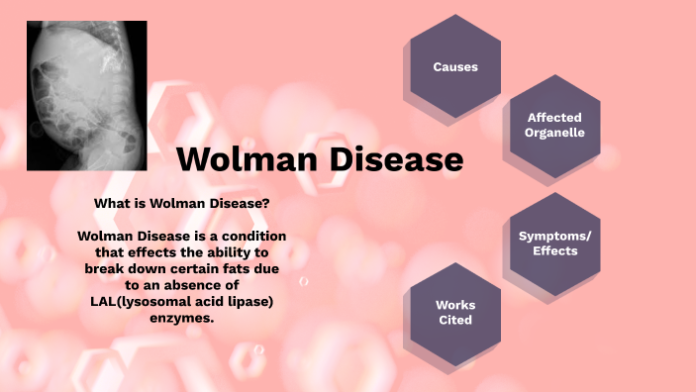Wolman disease, also known as lysosomal acid lipase deficiency (LAL-D), is a rare genetic disorder characterized by the body’s inability to break down certain fats (lipids), leading to their accumulation in various organs and tissues. Here’s an overview of its symptoms, causes, treatment, and prevention:
Symptoms:
-
- Hepatomegaly (enlarged liver)
- Splenomegaly (enlarged spleen)
- Failure to thrive
- Malabsorption
- Jaundice
- Growth retardation
- Vomiting
- Diarrhea
- Difficulty gaining weight
- Lipid-filled macrophages in various tissues
- Developmental delays
- Progressive liver disease
- Cardiovascular complications
Causes:
-
- Wolman disease is caused by mutations in the LIPA gene, which provides instructions for producing the lysosomal acid lipase (LAL) enzyme. This enzyme is responsible for breaking down cholesterol esters and triglycerides in cells.
Treatment:
-
- There is currently no cure for Wolman disease. Treatment primarily focuses on managing symptoms and complications. This may involve:
- Enzyme replacement therapy (ERT): This involves infusing the patient with a synthetic form of the missing enzyme to help break down lipids.
- Nutritional support: Patients may require special diets to help manage malabsorption and ensure adequate nutrition.
- Symptomatic treatment: Medications and interventions may be prescribed to manage specific symptoms or complications, such as liver disease or cardiovascular issues.
- Liver transplantation: In severe cases of liver disease, liver transplantation may be considered.
- There is currently no cure for Wolman disease. Treatment primarily focuses on managing symptoms and complications. This may involve:
Prevention:
-
- Since Wolman disease is a genetic disorder, prevention involves genetic counseling and testing for at-risk couples who may carry the mutated gene. This can help them make informed decisions about family planning.
- Prenatal testing: For couples with a family history of Wolman disease or known carriers of the mutated gene, prenatal testing can be performed to diagnose the condition in the fetus. This allows parents to make decisions about pregnancy management and future care for the child.

































